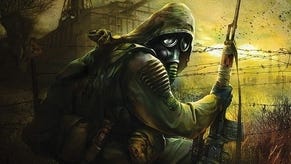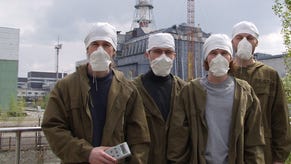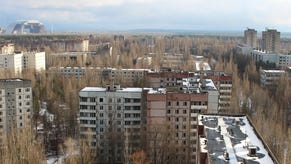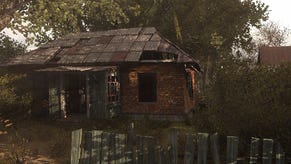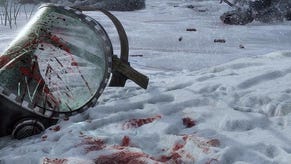S.T.A.L.K.E.R. dev diary
Shots, movie, history.
With much delayed PC first-person shooter S.T.A.L.K.E.R. set for release next year, publisher THQ is moving into promotional overdrive with a series of developer diaries from GSC Game World accompanied by trailers and new screenshots.
You can check out the latest visuals in our S.T.A.L.K.E.R. gallery, while a new movie is up on Eurogamer TV. For more insight into the game's development, and how the project fits in with Chernobyl nuclear disaster, you should also watch the latest episode of the Eurogamer TV Show.
But for now, we'll leave you with the first instalment of the developer's diary, which focuses on the events that took place in the early hours of an April morning 20 years ago when reactor four exploded with devastating consequences...
On 25th of April 1986 an experiment took place in the 4th block of the Chernobyl power plant. A team of engineers and scientists wished to verify that the turbines could produce enough power in the case of a total failure of electricity, thus ensuring that the emergency cooling would function correctly. To allow the experiment to take place under realistic conditions, the emergency program "Average Protection" was turned off. In so doing, all the important security functions such as the emergency cooling and the emergency retraction of the brake rods, were taken offline. However, the launch of the experiment was postponed, and the unprepared night shift undertook the experiment, failing to understand that the test environment that took place earlier in the day had left the reactor unprotected.
Through a simple operating mistake made by the inexperienced reactor engineer Leonid Toptunov, the performance of the reactor was massively reduced just a few moments before the beginning of the experiment. To return performance to normal, the operators removed the brake rods (which are used to control the atomic chain reaction) and the total number of engaged rods fell below the minimum safety limit of 28 rods. As a consequence, it became increasingly difficult to control the reactor.
Nevertheless, the deputy chief engineer of the power plant, Anatolij Djatlov, ordered the experiment to commence. Too many cooling pumps were closed and the reactor, which was already working with drastically-reduced performance, was not able to evaporate the cooling water. The water temperature started to rise and almost immediately the first hydraulic system failures could be heard. Akimov, the engineer in charge, and Toptunov wanted to stop the experiment, but Djatlov urged them on. It was 1.22:30 a.m.
When the operators switched off the electricity and the turbines stopped supplying power to the water-pumps, even less cooling water was pumped through the reactor core. The water became ever-hotter and quickly reached boiling point. Since a reactor can only be cooled adequately with enough evaporated water, its performance output increased. It was 1.23:04 a.m. At this point, "Average Protection" should have kicked in and would have averted the catastrophe, but it had never been reactivated following the earlier tests.
When Akimov noticed the mercurial performance boost of the reactor, he activated Average Protection manually at 1.23:40 a.m. All brake rods were retracted at once (over 200). But exactly at this point the RBMK-reactor hit its most serious construction failure: the retraction speed of the brake rods was extremely slow, much slower than the one of the West European countries. At the head of the brake rods were graphite spikes designed to accelerate the chain reaction. This was a key error in the construction and would prove the most fatal. The retraction of the brake rods was supposed to stop the chain reaction. The security system of every nuclear power plant is based on this concept. However, because the graphite-spikes were inserted first the performance was exponentially increased at his moment - the reactor hence was out of control.
The heat caused the channels of the brake rods to become irretrievably warped and the brake rods became lodged in the reactor core. The graphite-spikes were still inside the reactor; catastrophe was inevitable. In the active zone a chemical reaction took place between Zirconium and steam. Hydrogen and Oxygen were created to create the highly volatile oxyhydrogen. At 1.23:50 a.m. the entire reactor exploded and everything that surrounded it was obliterated. Most of the radioactive material was ejected outside. Everything in the immediate vicinity caught fire, including civilian houses that were in the neighborhood.
In the following weeks over 30 men died because of the high radiation - including firefighters, the two operators Akimov and Toptunov, as well as other staff of the nuclear power plant.
So called "Liquidators" (soldiers, students and volunteers) went to Chernobyl to decontaminate the power plant, to eliminate possible sources of danger that still existed and to alter the sarcophagus that was created to surround the destroyed 4th block. The number of people who helped is estimated between 600,000 and 1,200,000.
Most of the victims died because of late-stage radiation ailments such as cancer, heart-circulation problems and depression (suicide). Some people estimate the total number of victims ranges between 10,000 to 250,000. The actual number can never be accurately calculated, because even today people in Europe, especially those in Russia and Ukraine die from radiation-related illnesses, especially cancer. There is also a marked increase in the infant mortality rate and the general health of the children that grow up on the irradiated land are terrifying. These consequences will not last for just this generation...
According to recently-publicised conclusions made by a sixth investigatory group of "competent bodies" formed right after the accident to find the reasons causing the accident, "... The main reason of the accident was the low culture of workers of the atomic power station. The question is not in the qualification, but in the culture of working, internal discipline and feeling of the responsibility." (document #29 from May, 7th 1986). "The explosion has happened as a result of some rough infringements of work regulations, technology and disregard of the 4th block reactor safety regulations." (document #31 from May, 11th 1986).
S.T.A.L.K.E.R.: Shadow of Chernobyl aims to remind people about the accident in Chernobyl and is designed as a warning game against human carelessness and error able to cause global-scale disasters.


